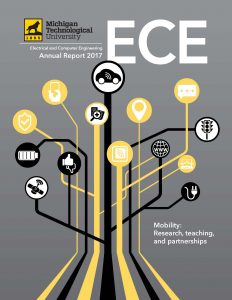 We are happy to share with you our newly released ECE Annual Report 2017. A look back at our past year highlights research activities from nine of our faculty members in the area of mobility, along with graduate students Mojtaba Bahramgiri, Derek Chopp, and Mehdi Jafari. We share in the good news received during the year in which three of our assistant professors received major early career awards: Lucia Gauchia and Zhaohui Wang received National Science Foundation CAREER awards and Jeremy Bos received the US Air Force Young Investigator Program award. We highlight two of our many outstanding undergraduate students, Brian Flanagan and Casey Strom, for accomplishments and contributions during their BS degree studies. This May we celebrated the 50th anniversary of the first female graduate of the Michigan Tech EE department, Pat Anthony. Pat was honored by the University during spring commencement and was also inducted into the ECE Academy. Once again the year included a wide variety of hands-on student projects in our Senior Design and Enterprise programs and we thank our sponsors for making it all possible! We invite you to read about these stories and more. From all of us at ECE, happy holidays and best wishes for 2018!
We are happy to share with you our newly released ECE Annual Report 2017. A look back at our past year highlights research activities from nine of our faculty members in the area of mobility, along with graduate students Mojtaba Bahramgiri, Derek Chopp, and Mehdi Jafari. We share in the good news received during the year in which three of our assistant professors received major early career awards: Lucia Gauchia and Zhaohui Wang received National Science Foundation CAREER awards and Jeremy Bos received the US Air Force Young Investigator Program award. We highlight two of our many outstanding undergraduate students, Brian Flanagan and Casey Strom, for accomplishments and contributions during their BS degree studies. This May we celebrated the 50th anniversary of the first female graduate of the Michigan Tech EE department, Pat Anthony. Pat was honored by the University during spring commencement and was also inducted into the ECE Academy. Once again the year included a wide variety of hands-on student projects in our Senior Design and Enterprise programs and we thank our sponsors for making it all possible! We invite you to read about these stories and more. From all of us at ECE, happy holidays and best wishes for 2018!
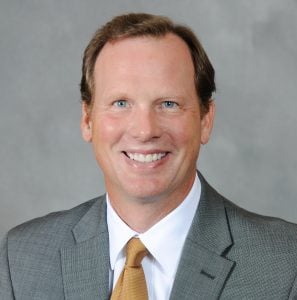 More than 360 bachelor’s, master’s and PhD recipients are expected to attend Midyear Commencement Saturday (Dec 16). Ceremonies will take place at 10:30 a.m. in the Wood Gym of the Student Development Complex.
More than 360 bachelor’s, master’s and PhD recipients are expected to attend Midyear Commencement Saturday (Dec 16). Ceremonies will take place at 10:30 a.m. in the Wood Gym of the Student Development Complex.
James Parm, partner at Inc. CEO Project, will deliver the commencement address for Michigan Tech’s Midyear. Parm graduated from Michigan Tech in 1981 with a bachelor’s degree in electrical engineering and was inducted into the ECE Academy in 2012.
In his current position, Parm provides business strategy to corporate CEOs. He has a long and distinguished career leading international technology companies including Stratos, Inmarsat PLC and Shell Offshore Services Company.
Parm and his wife Jean, a 1982 Tech graduate, have established the Jim and Jean Parm Endowed Scholarship. The Parms live in Casey Key, Florida. At the commencement ceremony, Parm will receive an Honorary Doctorate of Philosophy.
Tim Havens (ECE/CS) and Tony Pinar (ECE) published “Measures of the Shapley Index for Learning Lower Complexity Fuzzy Integrals” in Granular Computing and “Efficient Multiple Kernel Classification Using Feature and Decision Level Fusion” in IEEE Transactions on Fuzzy Systems, December 2017.
https://doi.org/10.1007/s41066-017-0045-6
Havens presented a paper co-authored by Pinar entitled “Generating Random Fuzzy (Capacity) Measures for Data Fusion Simulations” at the IEEE Symposium Series on Computational Intelligence (IEEE SSCI 2017) in Honolulu, HI, from Nov. 27 to Dec 1, 2017.
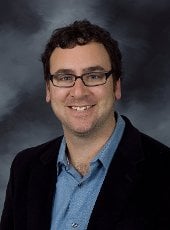
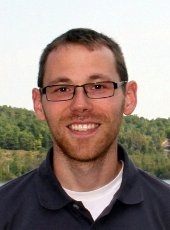
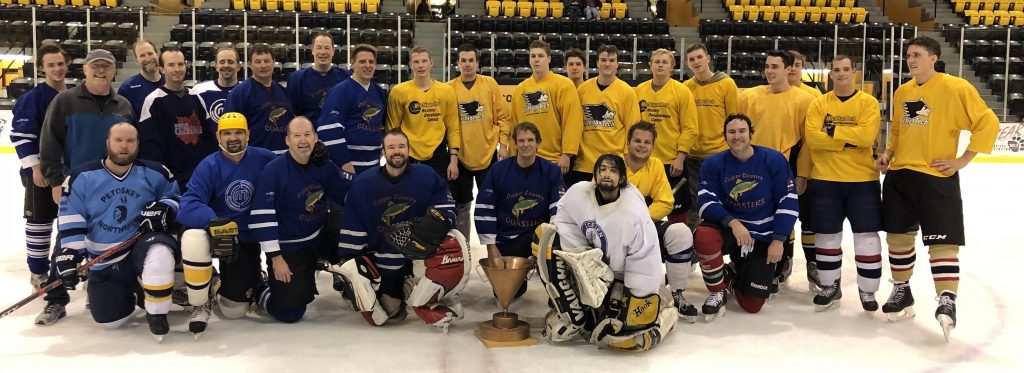 The faculty pulled out a thrilling 12-10 come-from-behind overtime victory in the 2017 edition of the annual ECE student-faculty hockey game, held at the MacInnes Ice Arena on Saturday, December 2. Both sides showed energy and enthusiasm in the first period, with goals see-sawing back and forth to a score of 5-4 with students in the lead at the end of the period. The defenses stepped it up in the second period, with only one goal scored mid-period by the faculty to even things up at 5-5, until the students scored two quick goals in the last 30 seconds to go ahead 7-5. In the last period, both sides battled to 10-8 with students on top with two minutes to go. The faculty pulled the goalie and scored two more goals to tie it up 10-10 with just seconds remaining. The game went to a 5-round shootout, which the faculty took in four rounds 2-0, for a final score of 12-10. Special mention goes to Mark Maroste for scoring two goals in regulation and one in the shootout, to Adam Webb for a hat trick in regulation and for the second and winning shootout goal, and to faculty goalie Brian Hutzler for turning away roughly 100 shots and shutting out the students in overtime.
The faculty pulled out a thrilling 12-10 come-from-behind overtime victory in the 2017 edition of the annual ECE student-faculty hockey game, held at the MacInnes Ice Arena on Saturday, December 2. Both sides showed energy and enthusiasm in the first period, with goals see-sawing back and forth to a score of 5-4 with students in the lead at the end of the period. The defenses stepped it up in the second period, with only one goal scored mid-period by the faculty to even things up at 5-5, until the students scored two quick goals in the last 30 seconds to go ahead 7-5. In the last period, both sides battled to 10-8 with students on top with two minutes to go. The faculty pulled the goalie and scored two more goals to tie it up 10-10 with just seconds remaining. The game went to a 5-round shootout, which the faculty took in four rounds 2-0, for a final score of 12-10. Special mention goes to Mark Maroste for scoring two goals in regulation and one in the shootout, to Adam Webb for a hat trick in regulation and for the second and winning shootout goal, and to faculty goalie Brian Hutzler for turning away roughly 100 shots and shutting out the students in overtime.
The game was enjoyed by the largest crowd ever to attend the annual department event, and the same crowd enjoyed numerous door prizes and pizza after the game. A good time was had by all, and many of the aging faculty players could still walk after it was all over.
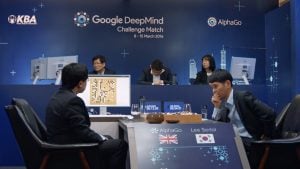 Tonight’s viewers of AlphaGo will get the opportunity to learn more on the research and application of artificial intelligence (AI) happening today, here at Michigan Tech and beyond. A panel discussion with Dr. Timothy Havens (ECE/CS), Dr. Laura Brown (CS), Dr. Steven Goldsmith (MEEM/ECE), Dr. Scott Marratto (HU), and Josh Manela (ECE alumnus) of Ford subsidiary Argo AI will follow the screening.
Tonight’s viewers of AlphaGo will get the opportunity to learn more on the research and application of artificial intelligence (AI) happening today, here at Michigan Tech and beyond. A panel discussion with Dr. Timothy Havens (ECE/CS), Dr. Laura Brown (CS), Dr. Steven Goldsmith (MEEM/ECE), Dr. Scott Marratto (HU), and Josh Manela (ECE alumnus) of Ford subsidiary Argo AI will follow the screening.
AlphaGo: 7:30 p.m. Friday, November 3, Rozsa Center for the Performing Arts
AlphaGo is featured in this year’s 41 North Film Festival hosted by the Rozsa Center for the Performing Arts. Directed by Greg Kohs, the documentary chronicles a journey from the halls of Cambridge, through the backstreets of Bordeaux, past the coding terminals of DeepMind in London, and, ultimately, to the seven-day tournament in Seoul. As the drama unfolds, more questions emerge: What can artificial intelligence reveal about a 3000-year-old game? What can it teach us about humanity?

For many students and instructors, the upcoming weeks are the most motivationally challenging of the academic year. Days are getting shorter, colder and darker with six solid weeks of class behind us and four more weeks ahead before a break.
But Michigan Tech’s terrific faculty routinely provide me with inspiration to keep me focused. I want to share a story I play back in my head on tougher days in hopes that it will inspire you too.
When I first became the CTL director, Glen Archer, principal lecturer and associate chair in Electrical and Computer Engineering, used to do me the favor of speaking near the end of Graduate Teaching Assistant (GTA) orientation each fall. Glen would remind the GTAs that they were going to be the “maximum in the room.”
What he meant was that any students would almost certainly reflect and rise only to the level of enthusiasm and motivation set by their instructor. Glen was challenging them to set that bar high.
Glen’s advice helps me focus on bringing my best self into the classroom, even on days when I’m distracted by non-teaching or personal business, teaching material I don’t find that interesting myself, or just plain tired. It helps me see that if I’m not leading the way with interest and enthusiasm, it’s pretty hard to expect that my students will follow.
On Nov. 30, Glen will be recognized with the final 2017 CTL Teaching Award for Excellence in Large Class Teaching. He’ll share other stories as part of this event; I encourage you to mark your calendar now so that you can attend and hear more words of wisdom from this terrific teacher.
If you’d like to talk more about ways to keep yourself and students motivated, stop into the William G. Jackson Center for Teaching and Learning.
From Terrific Teaching at Tech, by Mike Meyer, William G. Jackson CTL.
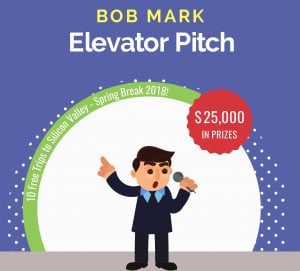 EE major Cameron Philo received “Best Green Innovation” at the 2017 Bob Mark Elevator Pitch Competition held Saturday in the Van Pelt and Opie Library.
EE major Cameron Philo received “Best Green Innovation” at the 2017 Bob Mark Elevator Pitch Competition held Saturday in the Van Pelt and Opie Library.
Philo was selected for his “3D Windmill,” a unique compact windmill design to bring electricity to underdeveloped regions. Along with the $250 cash prize, Philo will join the other 10 award recipients in Silicon Valley during Spring Break 2018.
For a complete list of prize winners see Tech Today.
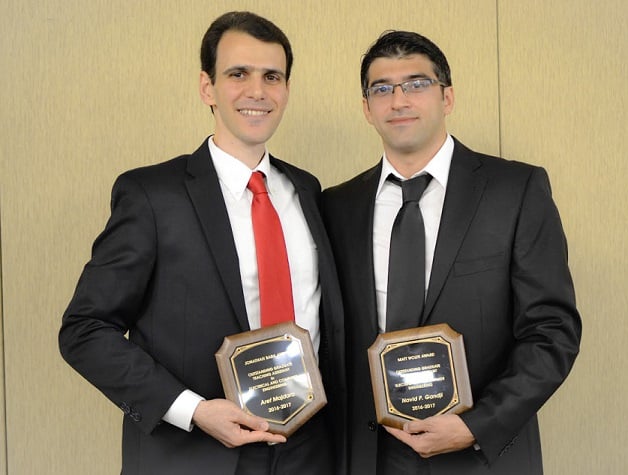
The Department of Electrical and Computer Engineering announced its award recipients for 2016-2017 at the Annual ECE Graduate Student Banquet held on September 25. Aref Majdara received the Jonathan Bara Award for Outstanding Graduate Teaching Assistant and Navid Gandji received the Matt Wolfe Award for Outstanding Graduate Research Assistant.
Dr. Glen Archer, ECE associate chair and TA supervisor said in his nomination “Aref is one of those rare students who seems to excel at everything you ask him to do. He has worked as a TA for several years in a variety of different courses and received praise from the students in every case.” Archer stated that Aref’s performance in the Circuits lab “revealed a quiet patience that motivates students to perform at their best” and in the more difficult to staff labs such as Microcontroller, Embedded System Engineering, and Signal Processing, “Aref accepted these challenges in the same way he faces everything, with purposeful resolve and a relentless pursuit of excellence”. Mr. Majdara’s PhD advisor is Prof. Saeid Nooshabadi.
Dr. Elena Semouchkina, ECE associate professor and PhD advisor stated in her nomination for outstanding GRA, “Navid Gandji’s research features two important aspects: (1) novelty at the frontiers of engineering physics and (2) addressing vital societal needs. Navid’s work is in a very competitive field of artificial materials, including photonic crystals and metamaterials, which were named by the American Physical Society as one of the top three physics discoveries of the first decade of the new century. His work comprises theoretical studies, full-wave electromagnetic simulations, and experiments on a unique automatic microwave field mapping fixture, which he helped to develop and advance.” Overall, during his PhD studies, Navid has authored and co-authored 4 journal papers, 4 more papers are in preparation. He has also authored and co-authored 5 published refereed conference proceedings and made two presentations at the IEEE International Symposium on Antennas and Propagation, the major forum in the field.
The ECE Department congratulates Aref and Navid and appreciates their many contributions to the department, university, and their field.
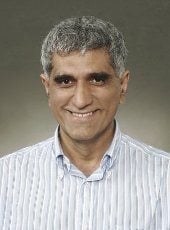
Saeid Nooshabadi (ECE/ICC) is the principal investigator on a project that has received $349,988 from the National Science Foundation for the project, “Collaborative Research: ACI-CDS&E: Highly Parallel Algorithms and Architectures for Convex Optimization for Realtime Embedded Systems (CORES).” This is a three-year project.
By Sponsored Programs.
Abstract
Embedded processors are ubiquitous, from toasters and microwave ovens, to automobiles, planes, drones and robots and are typically very small processors that are compute and memory constrained. Real-time embedded systems have the additional requirement of completing tasks within a certain time period to accurately and safely control appliances and devices like automobiles, planes, robots, etc. Convex optimization has emerged as an important mathematical tool for automatic control and robotics and other areas of science and engineering disciplines including machine learning and statistical information processing. In many fields, convex optimization is used by the human designers as optimization tool where it is nearly always constrained to problems solved in a few hours, minutes or seconds. Highly Parallel Algorithms and Architectures for Convex Optimization for Realtime Embedded Systems (CORES) project takes advantage of the recent advances in embedded hardware and optimization techniques to explore opportunities for real-time convex optimization on the low-cost embedded systems in these disciplines in milli- and micro-seconds.
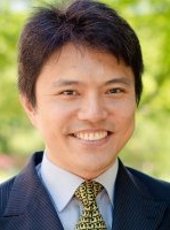
Chee-Wooi Ten (ECE) is the lead principal investigator on a project that has received a $348,866 research and development grant from the National Science Foundation (NSF). Yeonwoo Rho (Math/ICC) is the Co-PI on the project “CPS:Medium: Collaborative Research: An Actuarial Framework of Cyber Risk Management for Power Grids.” This is a three-year project.
There are two investigators from University of Wisconsin-Milwaukee.
The total for both universities is $700,975.
Abstract
As evidenced by the recent cyberattacks against Ukrainian power grids, attack strategies have advanced and new malware agents will continue to emerge. The current measures to audit the critical cyber assets of the electric power infrastructure do not provide a quantitative guidance that can be used to address security protection improvement. Investing in cybersecurity protection is often limited to compliance enforcement based on reliability standards. Auditors and investors must understand the implications of hypothetical worst case scenarios due to cyberattacks and how they could affect the power grids. This project aims to establish an actuarial framework for strategizing technological improvements of countermeasures against emerging cyberattacks on wide-area power networks.